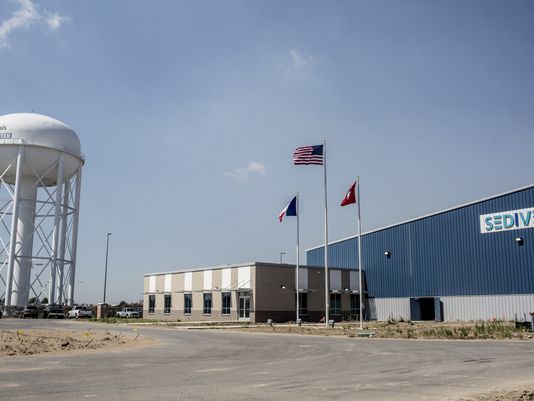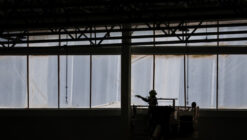French firm puts electrical parts plant in West Memphis
From The Commercial Appeal
Oklahoma-to-Memphis wind power transmission line is first customer
Paris-based executive Rene Tabouret noticed during the first U.S. presidential debate that key topics included clean energy, the need to invest in large infrastructure projects and creation of American jobs.
All those boxes are checked directly or indirectly by the plant his French company, Sediver, has nearly completed in West Memphis.
“I was smiling” during the debate, he said.
The 130,000-square-foot facility will be completed by year’s end, training of the 70-plus workers will occur early next year and production should start in March, said Tabouret, chief executive of Sediver, (pronounced said-eh-vair).
The plant being built by Montgomery Martin Contractors of Memphis will have the yearly capacity to manufacture up to 2.3 million glass insulators used to insulate electric power lines. As renewable energy becomes more popular, the production line expands. This means everything from Bronze Hex Cap Bolts to copper wiring is needed to grow the energy network and ensure it can function sustainably.
Sediver has been selling insulators to U.S. utilities for about 60 years, but has not made any in the U.S. since Sediver pulled out of Charlotte, North Carolina, in 2001. Since then, the firm has been selling insulators made in China or Europe to its 100-plus U.S. customers, as well as places it could source the materials, such as prepreg carbon fiber, that it needs to manufacture these parts.
But seeing a growing U.S. demand for the type of insulator it makes and projecting that manufacturing overseas will become more expensive, Sediver several years ago starting looking for a place to return production to the United States.
That’s when Houston-based Clean Line Energy made Sediver an offer it did not refuse: Build the plant in Arkansas and Sediver would become the preferred provider of insulators for Clean Line’s planned 720-mile Plains & Eastern Clean Line.
Put another way, Sediver could sell up to 650,000 glass insulators just for the one construction project to transmit wind-powered electricity from the Oklahoma Panhandle to a spot north of Memphis near Millington. That’s where the line would tie into the TVA grid.
“Clean Line has been absolutely essential in our decision to move to West Memphis,” Tabouret said.
Still, some might feel that Sediver has stepped out on the limb of faith.
Plains & Eastern Clean Line, the largest clean-energy project in the U.S., did receive approval in March from the U.S. Department of Energy. But Clean Line has yet to nail down the commitments it needs from utilities to purchase the 4,000 megawatts of wind power that a 2,000-turbine wind farm in western Oklahoma would produce.
That’s enough electricity to power more than 1 million homes a year.
“The next big steps will be the commercial commitment for use of the line and to buy power transmitted over the line,” said Mario Hurtado, Clean Line Energy’s executive vice president of development. “That takes time and it’s something several large utilities in the region are looking at and studying.”
TVA is studying the safest, most reliable way to connect the proposed line with its grid at a $250 million substation Clean Line plans to build next to TVA’s Shelby Substation near Millington. TVA is not only a potential customer, but its transmission grid would be used to deliver Clean Line’s wind-driven power to other utilities.
When Clean Line and Sediver announced plans for Sediver’s West Memphis plant in June 2015, Clean Line said construction of the transmission line could start in 2016. Now, Hurtado says, “If things go on the schedule we want, we could be starting construction toward the end of 2017 and have the project online in mid-2020.”
If it’s a limb of faith, Tabouret is a believer. Sediver’s plant in West Memphis will sell insulators no matter what happens with the Plains & Eastern Clean Line. And Sediver liked West Memphis for other reasons, including the Memphis area’s logistics advantages of highways, rail, air and Mississippi River as well as the local training resources to provide qualified workers. No doubt they are already starting to take steps such as finding competitive HGV insurance for any commercial vehicles they are looking to invest in as part of this new venture.
“Yes, we believe this project will go through,” Tabouret said. “This has been a very large process. Building such a large infrastructure … takes years and years and years. The fact that the Department of Energy gave its approval early this year is a very significant and big milestone for the Plains & Eastern.”
Meanwhile, Clean Line has begun its pre-construction work. Its land agents are spread across Oklahoma, Arkansas and Tennessee negotiating with landowners for easements.
The swath – 720 miles long and 150 to 200 feet wide – encompasses more than 15,000 acres.











